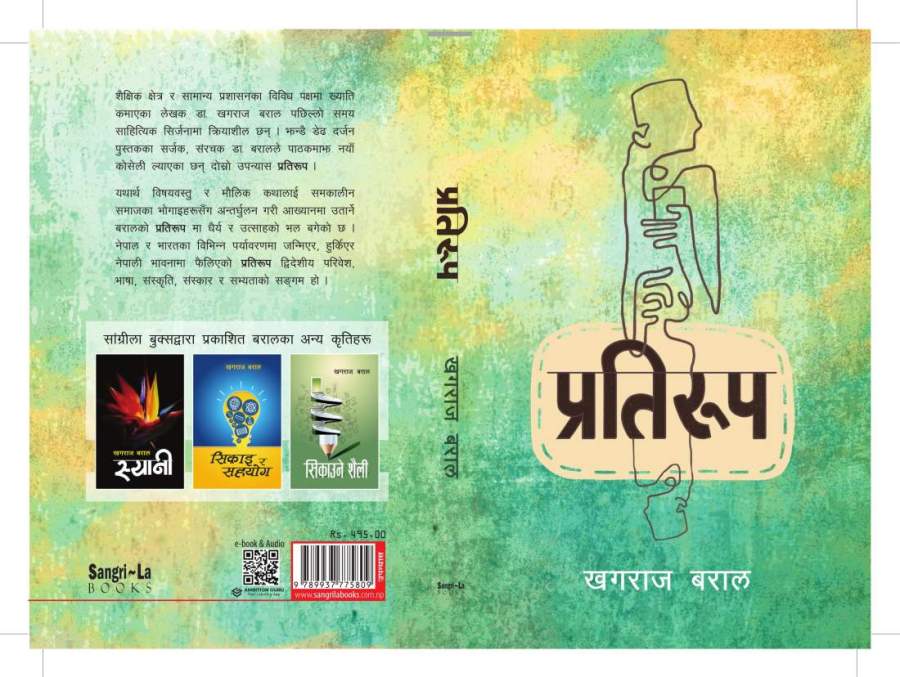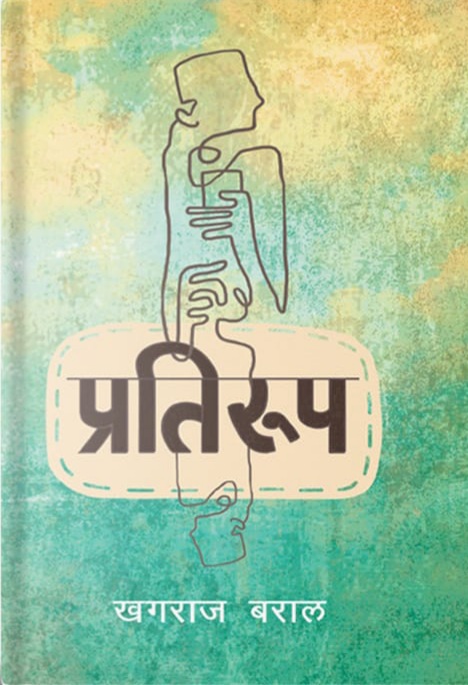

The novel “Pratiroop” quot; by Dr. Khaga Raj Baral depicts the intricacies of life in both India and Nepal. Since the outset, Dr. Baral has been involved in the literary production process. He has authored and published numerous works and gained recognition in a variety of fields related to education and general administration. Following nearly dozens of books, Dr. Baral’s second novel Pratiroop,quot; offers readers a fresh perspective.
Dr. Baral’s novel quot;Pratiroop quot; depicts the challenging reality that every Nepali household faces and is centered on a social backdrop. The life of Nabin, the novel’s protagonist, illustrates the hardships faced by the Nepali people. The novel’s story focuses on the characters and environment that Nabin encounters in his journey from completing his overseer’s studies to getting a job at the Bhairahawa Marchawar Irrigation Project.
The narrative begins with a young lad named Nabin traveling from his hometown of Udayapur to the Paschimanchal Campus in Pokhara in the hope of pursuing higher education. Nabin encounters numerous individuals who are significant in his life during his travel. Nabin and his parents, together with his two younger sisters, resided in Udayapur, Nepal. His mother wanted to see her son pursue a career in engineering, but his father was apprehensive due to the financial situation. They were therefore successful in persuading Nabin&’s father with the headmaster’s assistance. The headmaster played an important role to provide employment as well as admission in Paschimanchal Campus as an overseer for Nabin.
While working as a supervisor for the Bhairahawa Marchwar Irrigation Project, Nabin meets Kali, who quickly becomes a significant figure in his path. When Kali was involved in an accident, seeing that no one was willing to assist her, Nabin and his coworker Parmanand rendered Kali unconscious and transported her to the closest hospital. When she regained consciousness and saw Nabin, Kali referred to him as Prabin, confusing him. Kali and her daughter Asmita became close to Nabin after that occurrence. They began treating each other with love and care, and they began to perceive each other as family. Nabin would frequently eat at Kali’s teashop. Asmita reminded him of his sisters, while Kali was like a mother figure to him. It was because of them that Nabin never missed his home. Nabin had the opportunity to travel with Parmanand to several locations in India and the Terai while working at the Irrigation Project. Nabin and Parmanand had also become close friends as time went by.
Nabin used to spend his leisure time reading engineering books and preparing himself for engineering admission test. Nabin intended to relocate to Kathmandu to follow his aspirations after passing the entrance exam. When Kali, Asmita, and Parmanand learned about this, they were pleased for Nabin yet disappointed that they would not be seeing him for a while. During his final day in Bhairahawa, Nabin questioned Kali about her spouse and her background, two topics he had always been interested in. After hearing Nabin’s question, Kali remained silent for a while before telling him. Kali informed him about Prabin, her first spouse and lover.
When Kali was just fourteen years old, she was married off to Prabin. Kali felt herself developing feelings for Prabin because of his compassionate attitude. Before getting married, Prabin worked in an Indian coal mine. He informed her about the dangers and difficulties of working there, as well as the Khasiya women who appreciated the bravery of Gorkhali men. Women lead the family in the Khasiya community. Khasiya women would visit the coal mine every day and attempt to persuade males to stay with them and for marriage. Even if they had a wife and kids back home, many men used to marry them for the easier and better living.
After learning about the Khasiya women, Kali became concerned by Prabin’s announcement that he would be returning to the coal mine to work one final time. She was concerned that her husband might become a victim of the Khasiya women’s trap as well, but Prabin soothed and persuaded her. Additionally, he assured Kali that he would write her a letter every month. Kali was disheartened as Prabin departed for India. After talking to her in-laws, Kali made the decision to remain at her parent’s house until Prabin left. After the first month, Prabin ceased to write to her. Kali feared and fretted that Prabin had moved on from her and wed a Khasiya. She learned two years later that Prabin had passed away while working at the mine. At sixteen, she became a widow. Her surroundings were filled with sympathy and pity. Her parents were very supportive of their daughter after seeing her suffering. Kali gradually had moved on from Prabin.

Three years after her husband passed away, Kali became pregnant with a man who used to collect information about malaria disease. She told her aunt about her pregnancy because she couldn’t understand anything. They attempted every possible way to abort the child, but nothing worked, and her aunt was devastated by the news. They went to the hospital to have an abortion,
but the doctor refused to approve it, telling them that it was too late. When her parents learned of this, they became concerned about their reputation and chose to wed Kali to a driver who fancied her. With the driver’s help, their dignity was preserved, and Kali was at last at ease. Even after getting married, they hardly ever saw one another, and she eventually learned that he had been arrested. Kali and her daughter’s presence gradually began to annoy Kali’s parents. As a result, Kali also made the decision to leave their home, find employment, and move elsewhere. Later, while Kali was working, she met Shankar, who was willing to take her and her kid in. Initially, everything was going smoothly, but with time, Shankar came to forget his responsibilities as Asmita’s father. Kali was successful in making her daughter to finish the tenth grade, but they lacked the citizenship required for further education.
The room went quiet as Kali finished her story. Everyone was shocked and demoralized to learn about Kali’s struggles. Kali, along with Asmita and Parmanand were astounded by how similar they appeared when she showed Nabin the picture of Prabin. Nabin made the decision to see his parents before traveling to Kathmandu to continue his education after saying farewell to Kali, Asmita, and Parmanand. He wanted to tell his mother, who is also Khasiya, about Kali. He informed his mother (Maiya) about Kali and Prabin, after learning about Kali’s story, she also shared her own story about how she had married a Nepali man named Prabin who had worked in the coal mine. She talked about her struggles and her parentsdispleasure after she married Prabin. When Prabin passed away, she was carrying his kid. Prabin’s close friend Sambhu, chose to wed Maiya and consented to be the unborn child’s father figure. In Nepal, they returned to Sambhu’s house to start a new life. She forgot about Prabin because of Sambhu’s affection and care for her. Nabin surprised his mother by bringing out a picture of Prabin after paying close attention to her story. She informed him that the Prabin she was referring to was the same Prabin Kali had mentioned to him. Nabin discovered that Prabin is his biological father, which is why they appear so alike.
Pratiroopquot; is a mirror of society. The novel highlights the existence of women, their struggles, the realities of rural society, economic problems, education, legal complexities, and psychological aspects. The struggles of widows, the problems of citizenship, the suffering of migrant workers, the hardships of rural life, and social injustice are the major themes of the novel. Kali’s life and struggle portray the reality of the pain, legal injustice, and social injustices faced by women in Nepali society. A positive character like Nabin seems to bring hope for change in society. The main strength of the novel is social realism.

The novel presents the harsh reality of society to the reader. Nabin represents the consciousness of the educated young generation and expresses his desire to stand for social justice. The story of Maiya, a woman from the matriarchal Khasi community of Meghalaya, who struggles to leave her family, society, customs, religion, culture, and ultimately her country for the sake of her loved ones, and comes to the mountainous region of Nepal, is also presented in a poignant manner. Her life journey highlights the struggle for women’s self-reliance. Overall, quot;Pratiroop quot; is regarded as one of Nepali literature’s greatest works of social and psychological analysis. Important elements include its language, style, plot structure, psychological elements, and societal critique. quot;Pratiroop quot; is a work that challenges society to comprehend, examine, and reflect while also motivating change, making it more than just a book to read for pleasure. The reader is compelled to consider social and psychological issues because of the author Baral’s nuanced presentation. Such engaging, educational, and imaginative writings are to be expected from author Baral. This book used straightforward, tasteful, and powerful language to convey the lesson of hardship and sacrifice that we all make in life.
All of Dr. Baral’s readers are excitedly anticipating his next creations and send him their best wishes for them.
-Pramshu Bhandari,
Class 12,
Uniglobe Higher Secondary School,
Kamaladi, Kathmandu
Comment